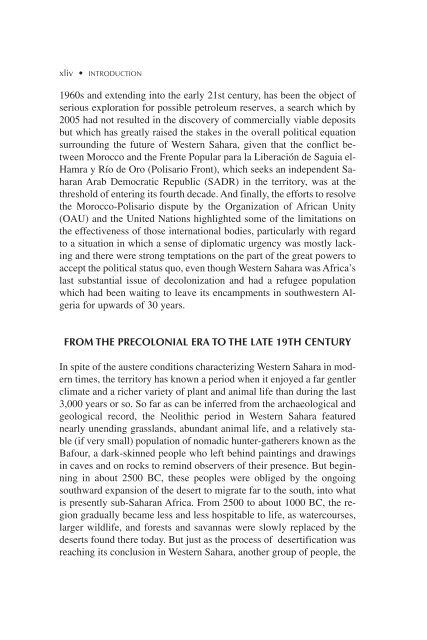Historical Dictionary of Western Sahara Third ... - Scarecrow Press
Historical Dictionary of Western Sahara Third ... - Scarecrow Press
Historical Dictionary of Western Sahara Third ... - Scarecrow Press
You also want an ePaper? Increase the reach of your titles
YUMPU automatically turns print PDFs into web optimized ePapers that Google loves.
xliv • INTRODUCTION<br />
1960s and extending into the early 21st century, has been the object <strong>of</strong><br />
serious exploration for possible petroleum reserves, a search which by<br />
2005 had not resulted in the discovery <strong>of</strong> commercially viable deposits<br />
but which has greatly raised the stakes in the overall political equation<br />
surrounding the future <strong>of</strong> <strong>Western</strong> <strong>Sahara</strong>, given that the conflict between<br />
Morocco and the Frente Popular para la Liberación de Saguia el-<br />
Hamra y Río de Oro (Polisario Front), which seeks an independent <strong>Sahara</strong>n<br />
Arab Democratic Republic (SADR) in the territory, was at the<br />
threshold <strong>of</strong> entering its fourth decade. And finally, the efforts to resolve<br />
the Morocco-Polisario dispute by the Organization <strong>of</strong> African Unity<br />
(OAU) and the United Nations highlighted some <strong>of</strong> the limitations on<br />
the effectiveness <strong>of</strong> those international bodies, particularly with regard<br />
to a situation in which a sense <strong>of</strong> diplomatic urgency was mostly lacking<br />
and there were strong temptations on the part <strong>of</strong> the great powers to<br />
accept the political status quo, even though <strong>Western</strong> <strong>Sahara</strong> was Africa’s<br />
last substantial issue <strong>of</strong> decolonization and had a refugee population<br />
which had been waiting to leave its encampments in southwestern Algeria<br />
for upwards <strong>of</strong> 30 years.<br />
FROM THE PRECOLONIAL ERA TO THE LATE 19TH CENTURY<br />
In spite <strong>of</strong> the austere conditions characterizing <strong>Western</strong> <strong>Sahara</strong> in modern<br />
times, the territory has known a period when it enjoyed a far gentler<br />
climate and a richer variety <strong>of</strong> plant and animal life than during the last<br />
3,000 years or so. So far as can be inferred from the archaeological and<br />
geological record, the Neolithic period in <strong>Western</strong> <strong>Sahara</strong> featured<br />
nearly unending grasslands, abundant animal life, and a relatively stable<br />
(if very small) population <strong>of</strong> nomadic hunter-gatherers known as the<br />
Bafour, a dark-skinned people who left behind paintings and drawings<br />
in caves and on rocks to remind observers <strong>of</strong> their presence. But beginning<br />
in about 2500 BC, these peoples were obliged by the ongoing<br />
southward expansion <strong>of</strong> the desert to migrate far to the south, into what<br />
is presently sub-<strong>Sahara</strong>n Africa. From 2500 to about 1000 BC, the region<br />
gradually became less and less hospitable to life, as watercourses,<br />
larger wildlife, and forests and savannas were slowly replaced by the<br />
deserts found there today. But just as the process <strong>of</strong> desertification was<br />
reaching its conclusion in <strong>Western</strong> <strong>Sahara</strong>, another group <strong>of</strong> people, the
















